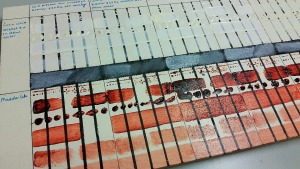
My name is Shelle Butler and I am a chemistry graduate student from the College of William and Mary conducting summer research for cultural heritage in the Netherlands with the International Research Experience for Students (IRES) program funded by the National Science Foundation (NSF). Back home in Williamsburg, Virginia under the mentorship of Dr. Kristin Wustholz and Colonial Williamsburg Foundation senior paintings conservator Shelley Svoboda, I perform surface-enhanced Raman spectroscopy (SERS) analysis on microscopic samples and cross sections from paintings to identify pigments and binding media.
Now, I find myself in a new land, the Netherlands. This once in a lifetime collaboration transports me from the early American colonial period to the Dutch Golden Age, where Rembrandt Harmenszoon van Rijn and Johannes Vermeer painted their masterpieces of Dutch history and the intimate scenes of Dutch domestic life in the 17th century. I bring with me an innate curiosity, a passion for both art and science, and my SERS experience.

So, why is SERS so important? It can often be difficult to identify a specific pigment by other analysis techniques. The use of light microscopy and scanning electron microscopy along with X-ray elemental analyses can be used to elucidate elemental composition in the paint cross-section, but does not identify some pigments, called lakes, whose color is not derived from minerals but from organic colorants.. Additionally, high-performance liquid chromatography (HPLC) is commonly used to identify the organic dye of the pigment, but requires a larger sample. When we are talking about precious artworks, we want a minimally to non-destructive analytical technique.
Raman spectroscopy is a vibrational spectroscopic technique commonly applied to reveal a structural fingerprint, which can be utilized to identify molecules. Normal Raman spectroscopy works well with many pigment samples, such as the strong signal observed with vermillion, a red inorganic pigment from the mineral cinnabar. However, for some samples, like red organic lake pigments, the Raman signal is too weak and is often hidden by powerful fluorescence, which conceals the chemical fingerprint needed for identification. To reveal the hidden information, the SERS technique is applied by adding nanoparticles made from noble metals (e.g. silver, gold, or platinum) to the surface of the sample to serve as antennae that amplify the Raman signal and subdue interference caused by fluorescence.

For paintings conservation, the SERS technique can be used to answer questions about the artist’s palette, their original intent, and can aid in digital reconstruction to visualize the painting’s original appearance to virtually resolve centuries of fading and degradation caused by light exposure and other environmental factors. Together with Dutch scientists at the Rijksmuseum, I am working to develop a Raman database and a protocol for SERS cross section analysis for red lake pigments, including carmine lake (a pigment made from the cochineal insect), madder lake (a pigment made from plant root), and brazilwood (from the tropical hardwood). I am starting with known reference material for protocol development and optimization. Once this has been accomplished, we can then move on to the analysis of works by the Dutch Golden Age master painter, Rembrandt!